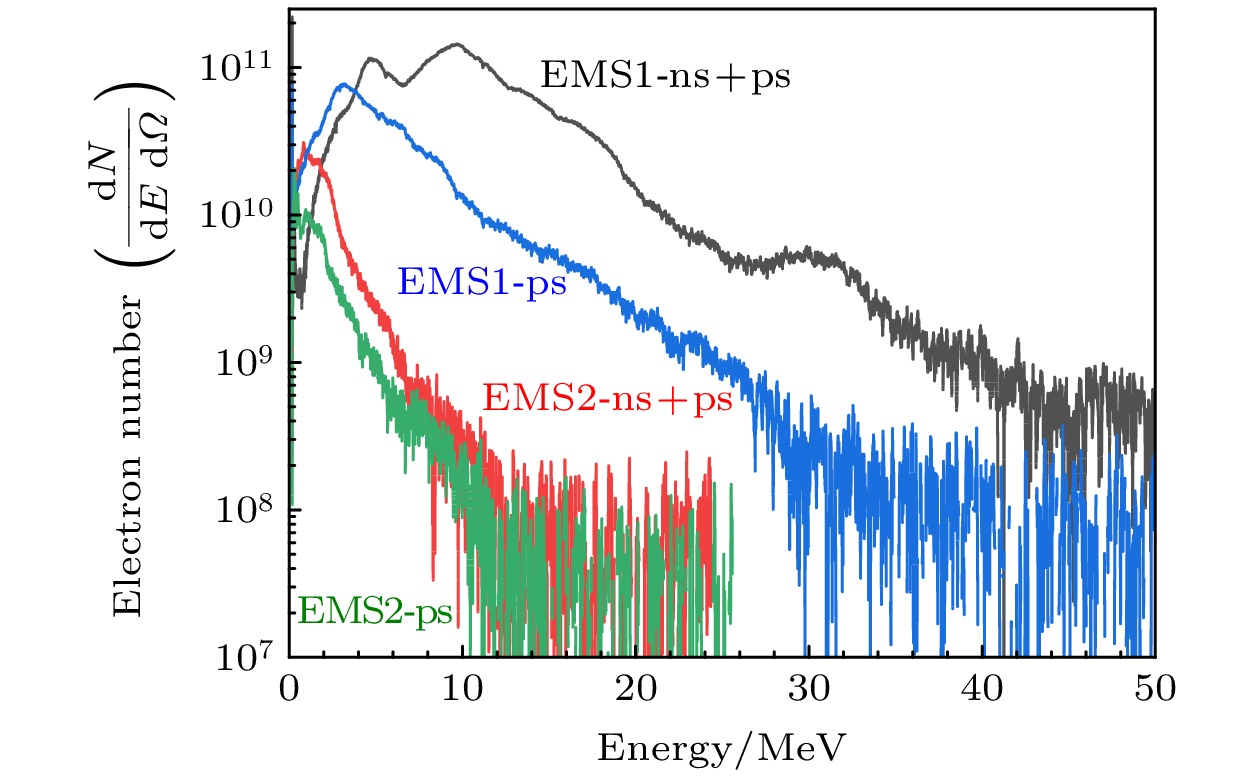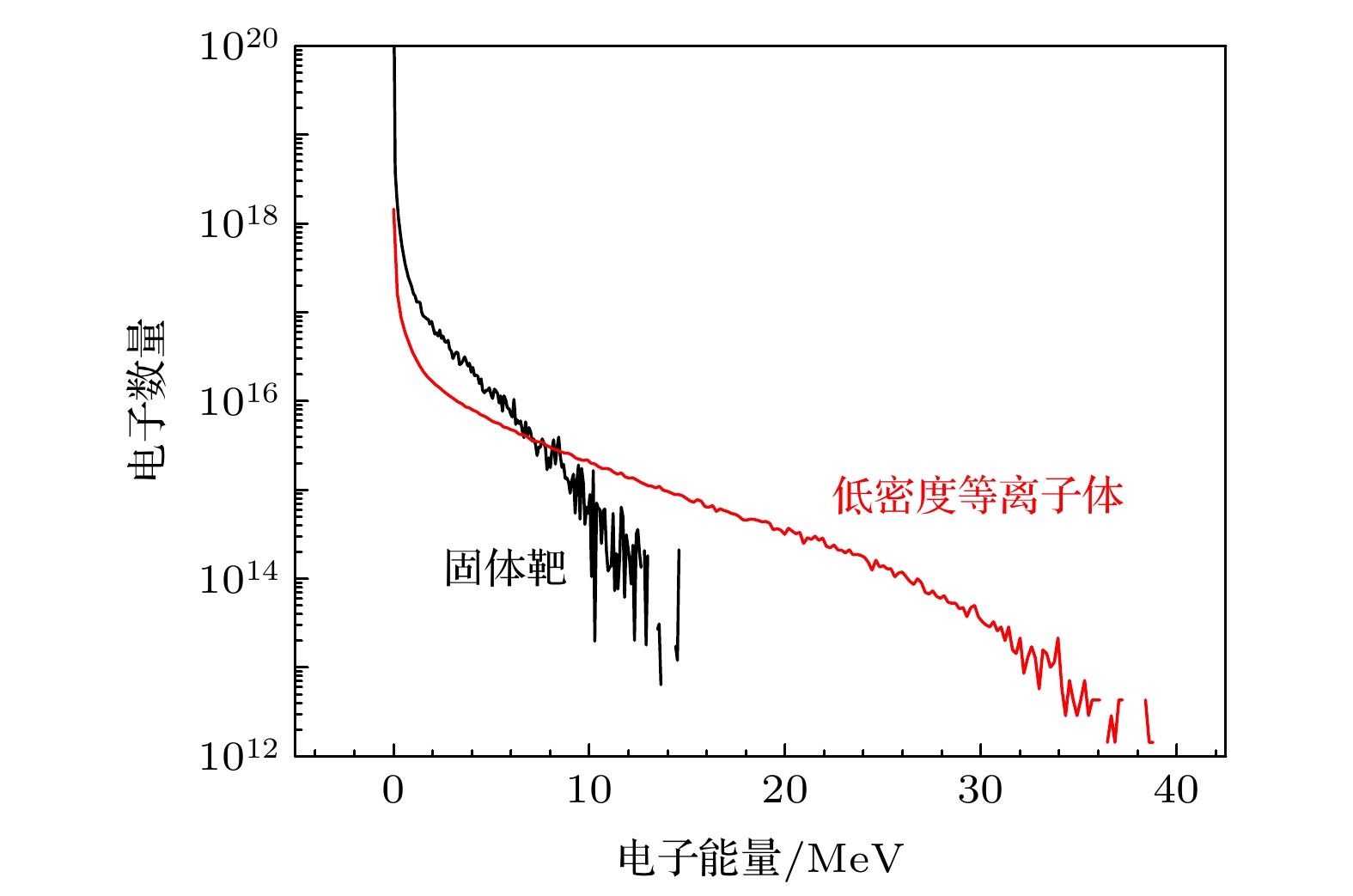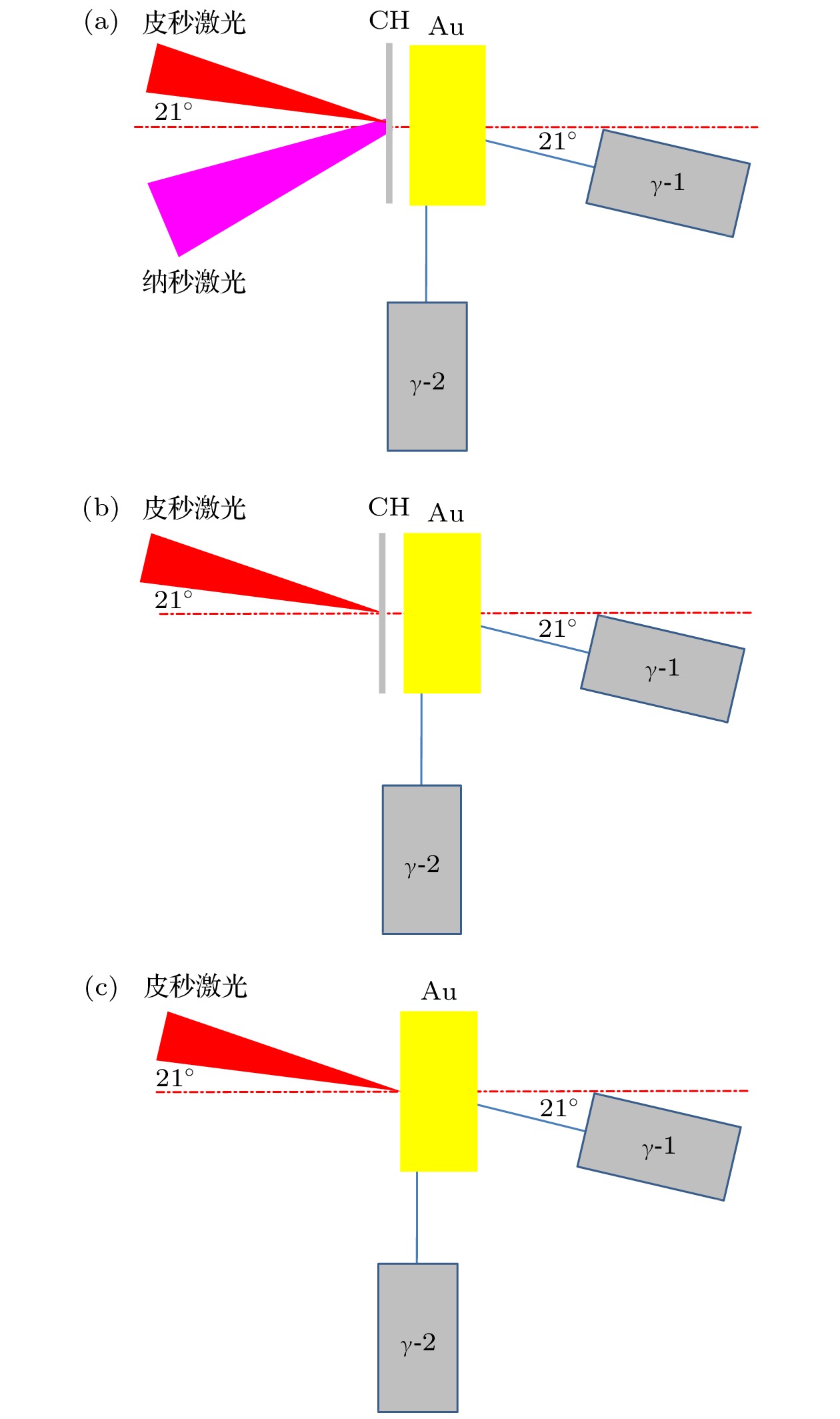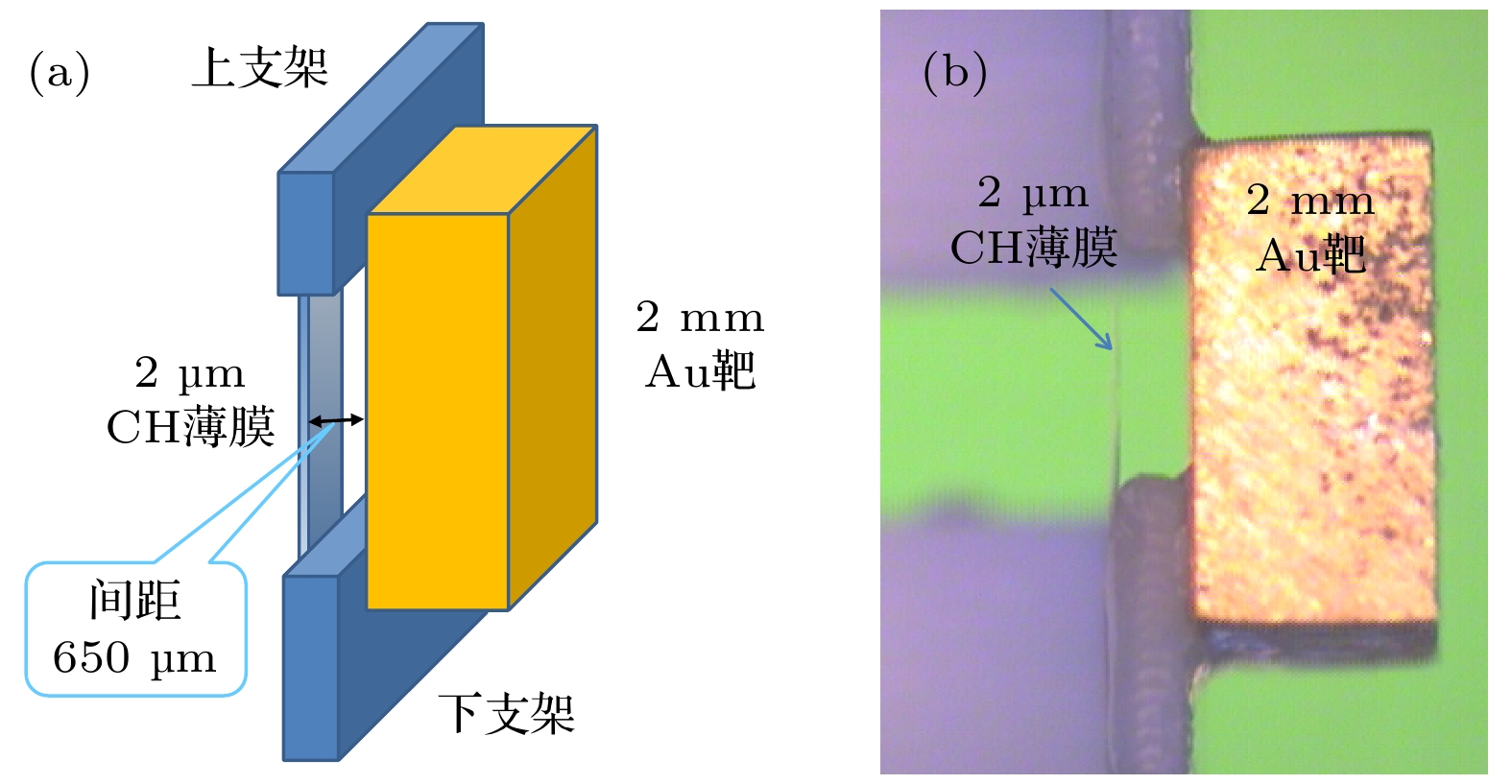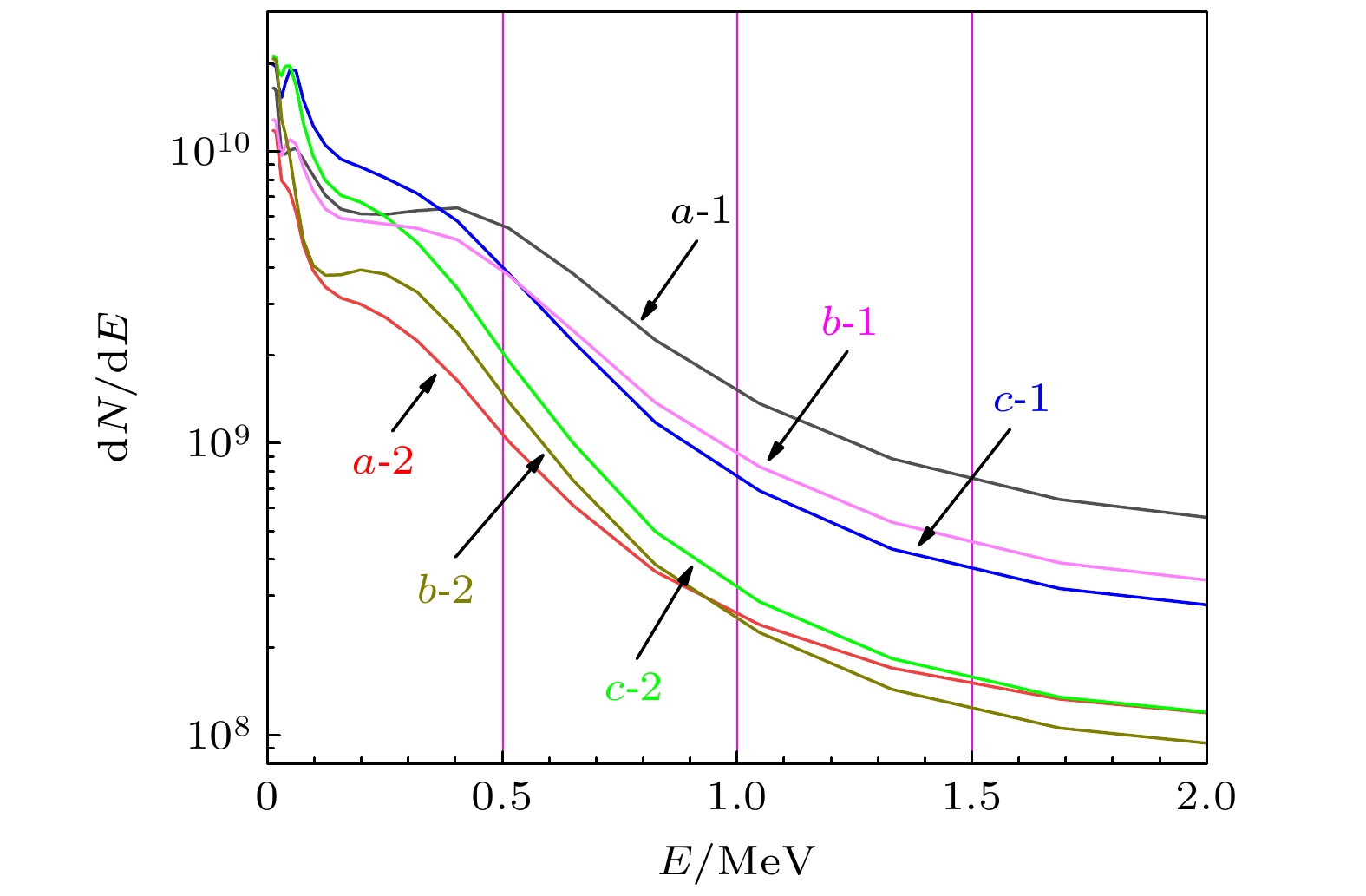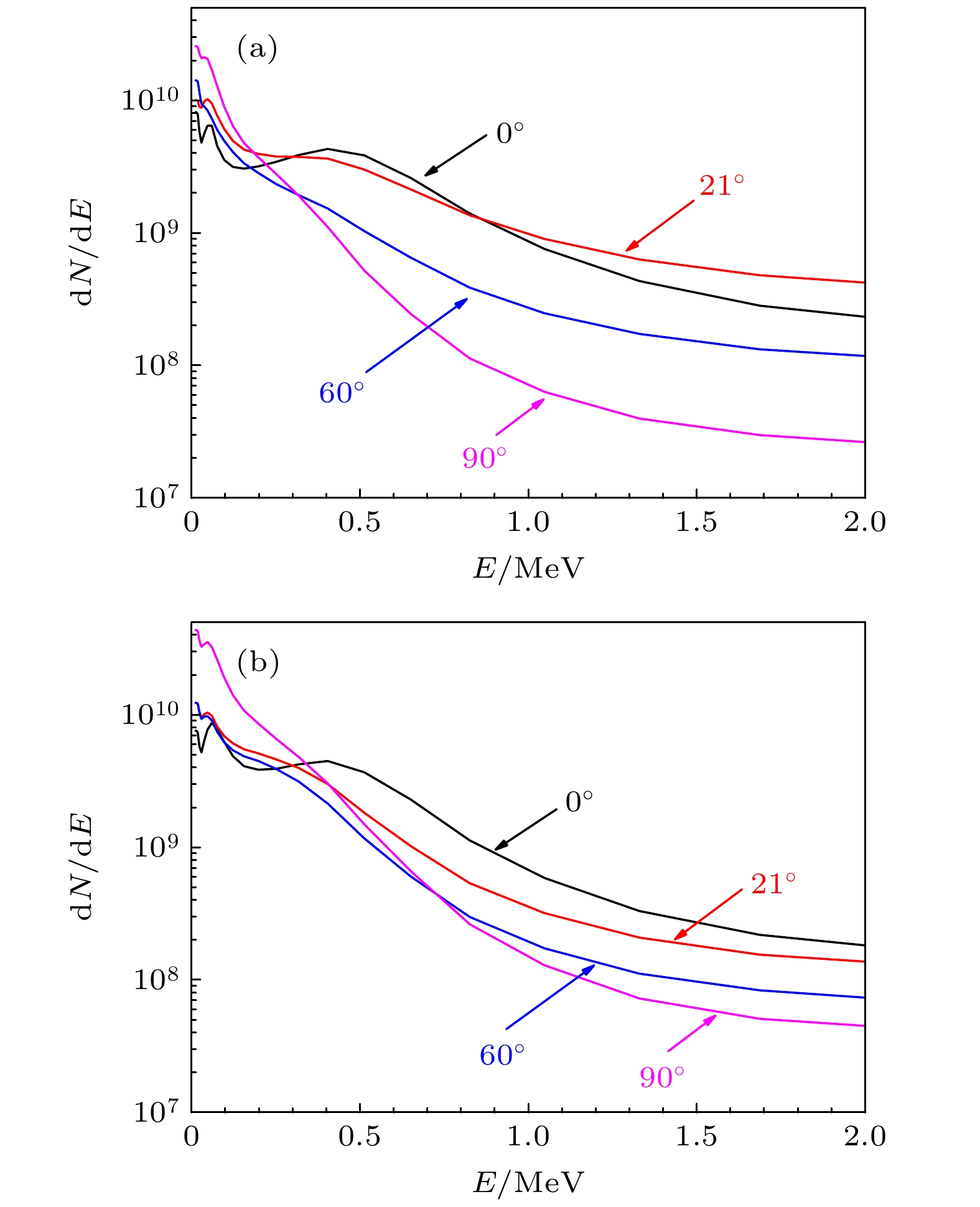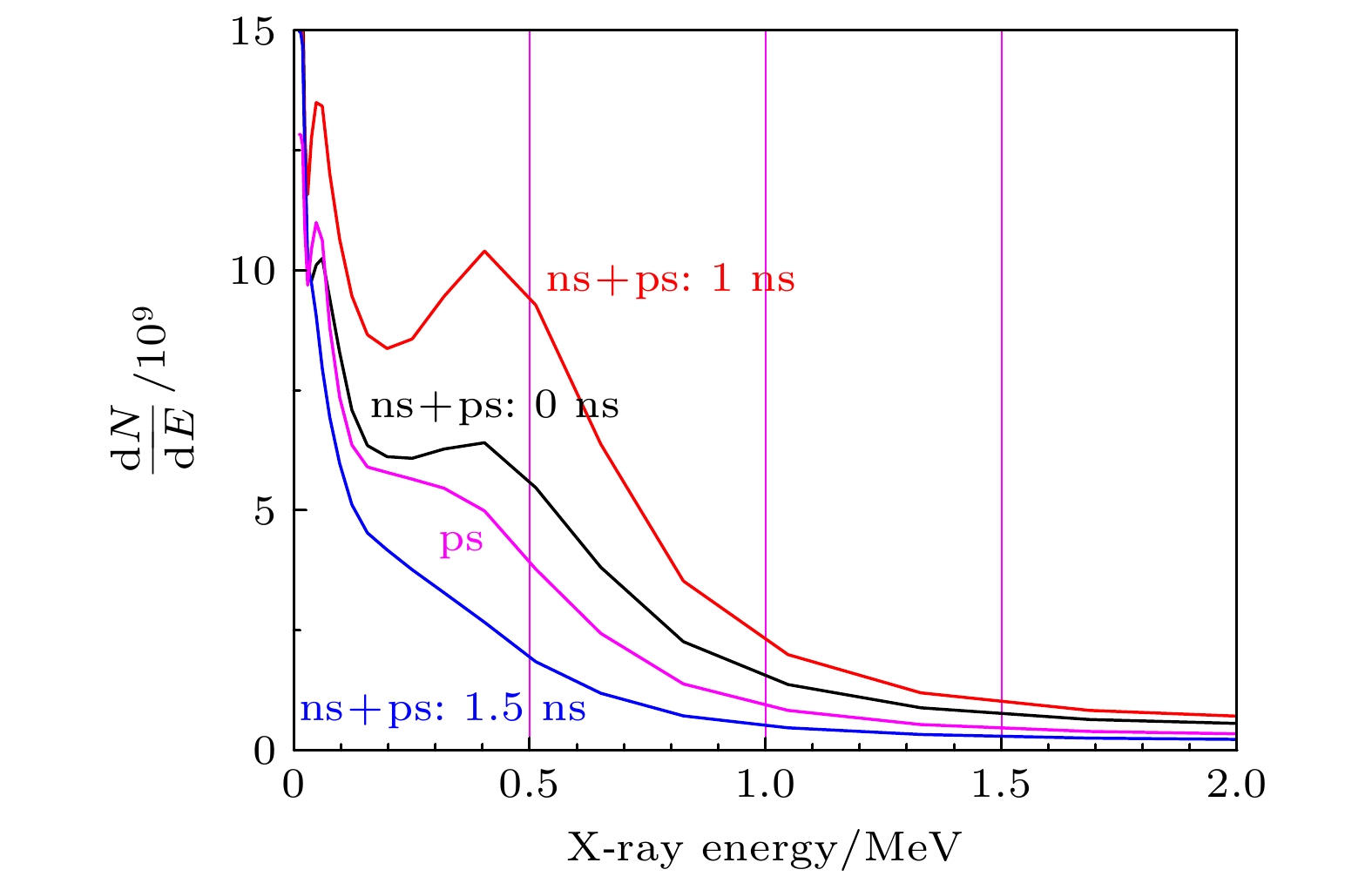-
In order to verify that the large-scale low-density plasma has a significant gain effect on the quality of the ultra-hot electron beam in ultra-strong ultra-short pulse laser interactions with matter, on the Shenguang-II upgraded laser facility, we carry out an experimental study on the optimization of relativistic electron beams that combine long and short pulse lasers to generate large-scale low-density pre-plasma. A nanosecond laser is used to ablate the thin hydrocarbon film. After a period of time, a large-scale low-density plasma is formed. The second picosecond short pulse laser then interacts with the formed low-density plasma, and accelerates the electrons to the relativity magnitude. Through the comparative analysis between different experimental conditions in the experiment, it is found that the existence of large-scale low-density plasma significantly increases the intensity of the relativistic electron beam along the laser propagation direction. In the comparative test of three shooting methods (long and short pulse combined driving double-layer target, short pulse driving double-layer target, short pulse driving single-layer target), we find that the energy bands above 1 MeV can be produced by the long pulse and the short pulse jointly driving double-layer target. The gamma-ray intensity is nearly twice that of the other two schemes. In addition, we also find in the experiment that when the time interval between nanosecond-picosecond pulses changes, the pre-plasma electron density and density scale length of the CH film irradiated by the nanosecond laser will be different. When the time interval is 0 ns, the expansion of the plasma is still insufficient, and the density distribution of the pre-plasma is steep. Part of the picosecond laser energy will be reflected at the critical density surface. Insufficient absorption of picosecond laser energy reduces the generation of relativistic electrons.When the time interval is 1 ns, the plasma state is more appropriate. The picosecond laser will form a self-focusing plasma channel in the plasma, thereby efficiently depositing energy, breaking through the energy limit of ponderomotive force acceleration, and obtaining more higher energy relativistic electrons. When the time interval is longer, such as 1.5 ns or more, the plasma can be fully expanded, the electron density becoming too low. Most of the picosecond laser will pass through the pre-plasma, affecting energy deposition and failing to generate more relativistic electrons.
[1] Glinec Y, Faure J, Dain L L, Darbon S, Hosokai T, Santos J J, Lefebvre E, Rousseau J P, Burgy F, Mercier B, Malka V 2005 Phys. Rev. Lett. 94 025003
 Google Scholar
Google Scholar
[2] Sarri G, Corvan D J, Schumaker W, Cole J M, Piazza A D, Ahmed H, Harvey C, Keitel C H, Krushelnick K, Mangles S P D, Najmudin Z, Symes D, Thomas A G R, Yeung M, Zhao Z, Zepf M 2014 Phys. Rev. Lett. 113 224801
 Google Scholar
Google Scholar
[3] Ben-Ismail A, Lundh O, Rechatin C, Lim J K, Faure J, Corde S, Malka V 2011 Appl. Phys. Lett. 98 264101
 Google Scholar
Google Scholar
[4] Sarri G, Schumaker W, Piazza A D, Vargas M, Dromey B, Dieckmann M E, Chvykov V, Maksimchuk A, Yanovsky V, He Z H, Hou B X, Nees J A, Thomas A G R, Keitel C H, Zepf M, Krushelnick K 2013 Phys. Rev. Lett. 110 255002
 Google Scholar
Google Scholar
[5] Schlenvoigt H P, Haupt K, Debus A, Budde F, Jaroszynski D A 2008 Nat. Phys. 4 130
 Google Scholar
Google Scholar
[6] Giulietti A, Bourgeois N, Ceccotti T, Davoine X, Dobosz S, D’Oliveira P, Galimberti M, Galy J, Gamucci A, Giulietti D, Gizzi L A, Hamilton D J, Lefebvre E, Labate L, Marquès J R, Monot P, Popescu H, Réau F, Sarri G, Tomassini P, Martin P 2008 Phys. Rev. Lett. 101 105002
 Google Scholar
Google Scholar
[7] Pomerantz I, McCary E, Meadows A R, Arefiev A, Bernstein A C, Chester C, Cortez J, Donovan M E, Dyer G, Gaul E W, Hamilton D, Kuk D, Lestrade A C, Wang C, Ditmire T, Hegelich B M 2014 Phys. Rev. Lett. 113 184801
 Google Scholar
Google Scholar
[8] Cowan T E, Hunt A W, Phillips T W, Wilks S C, Perry M D, Brown C, Fountain W, Hatchett S, Johnson J, Key M H, Parnell T, Pennington D M, Snavely R A, Takahashi Y 2000 Phys. Rev. Lett. 84 903
 Google Scholar
Google Scholar
[9] Sorokovikova A, Arefiev AV, Mcguffey C, Qiao B, Robinson A P L, Wei H S, Mclean H S, Beg F N 2016 Phys. Rev. Lett. 116 155001
 Google Scholar
Google Scholar
[10] Malka G, Miquel J L 1996 Phys. Rev. Lett. 77 75
 Google Scholar
Google Scholar
[11] Pukhov A, Meyer-ter-Vehn J 1998 Phys. Plasmas 5 1880
 Google Scholar
Google Scholar
[12] Culfa O, Tallents G J, Wagenaars E, Ridgers C P, Dance R J, Rossall A K, Gray R J, McKenna P, Brown C D R, James S F, Hoarty D J, Booth N, Robinson A P L, Lancaster K L, Pikuz S A, Faenov A Y, Kampfer T, Schulze K S, Uschmann I, Woolsey N S 2014 Phys. Plasmas 21 043106
 Google Scholar
Google Scholar
[13] Ting A, Moore C I, Krushelnick K, Manka C, Esarey E, Sprangle P, Hubbard R, Burris H R, Fischer R, Baine M 1997 Phys. Plasmas 4 1889
 Google Scholar
Google Scholar
[14] Arber T D, Bennett K, Brady C S, Lawrence-Douglas A, Ramsay M G, Sircombe N J, Gillies P, Evans R G, Schmitz H, Bell A R, Ridgers C P 2015 Plasma Phys. Control. Fusion 57 113001
 Google Scholar
Google Scholar
[15] Gibbon P, Andreev A A, Platonov K Y 2012 Plasma Phys. Control. Fusion 54 045001
 Google Scholar
Google Scholar
[16] Young P E, Hammer J H, Wilks S C, Kruer W L 1995 Phys. Plasmas 2 2825
 Google Scholar
Google Scholar
[17] Sarri G, Dieckmann M E, Brown C R D, Cecchetti C A, Hoarty D J, James S F, Jung R, Kourakis I, Schamel H, Willi O, Borghesi M 2010 Phys. Plasmas 17 010701
 Google Scholar
Google Scholar
[18] Friou A, Lefebvre E, Gremillet L 2012 Phys. Plasmas 19 022704
 Google Scholar
Google Scholar
[19] Pukhov A, Meyer-Ter-Vehn J N 1996 Phys. Rev. Lett. 76 3975
 Google Scholar
Google Scholar
[20] Lasinski B F, Langdon A B, Hatchett S P, Key M H, Tabak M 1999 Phys. Plasmas 6 2041
 Google Scholar
Google Scholar
[21] Li G, Yan R, Ren C, Wang T L, Tonge J, Mori W B 2008 Phys. Rev. Lett. 100 125002
 Google Scholar
Google Scholar
[22] Arefiev A V, Robinson A, Khudik V N 2015 Phys. Plasmas 81 475810404
 Google Scholar
Google Scholar
[23] Arefiev A V, Khudik VN, Robinson A, Shvets G, Willingale L, Schollmeier M 2016 Phys. Plasmas 23 056309
 Google Scholar
Google Scholar
-
表 1 不同能量处3种方案获得的伽马射线强度
Table 1. Gamma ray intensity obtained by the three schemes at different energies.
能量/MeV 伽马射线强度/108 a-1 b-1 c-1 (a – c)/c (b – c)/c 0.5 55.6 38.6 40.1 39% –3.7% 1.0 15.3 9.34 7.79 96% 20% 1.5 7.56 4.58 3.78 100% 21% 2.0 5.60 3.42 2.80 100% 22% -
[1] Glinec Y, Faure J, Dain L L, Darbon S, Hosokai T, Santos J J, Lefebvre E, Rousseau J P, Burgy F, Mercier B, Malka V 2005 Phys. Rev. Lett. 94 025003
 Google Scholar
Google Scholar
[2] Sarri G, Corvan D J, Schumaker W, Cole J M, Piazza A D, Ahmed H, Harvey C, Keitel C H, Krushelnick K, Mangles S P D, Najmudin Z, Symes D, Thomas A G R, Yeung M, Zhao Z, Zepf M 2014 Phys. Rev. Lett. 113 224801
 Google Scholar
Google Scholar
[3] Ben-Ismail A, Lundh O, Rechatin C, Lim J K, Faure J, Corde S, Malka V 2011 Appl. Phys. Lett. 98 264101
 Google Scholar
Google Scholar
[4] Sarri G, Schumaker W, Piazza A D, Vargas M, Dromey B, Dieckmann M E, Chvykov V, Maksimchuk A, Yanovsky V, He Z H, Hou B X, Nees J A, Thomas A G R, Keitel C H, Zepf M, Krushelnick K 2013 Phys. Rev. Lett. 110 255002
 Google Scholar
Google Scholar
[5] Schlenvoigt H P, Haupt K, Debus A, Budde F, Jaroszynski D A 2008 Nat. Phys. 4 130
 Google Scholar
Google Scholar
[6] Giulietti A, Bourgeois N, Ceccotti T, Davoine X, Dobosz S, D’Oliveira P, Galimberti M, Galy J, Gamucci A, Giulietti D, Gizzi L A, Hamilton D J, Lefebvre E, Labate L, Marquès J R, Monot P, Popescu H, Réau F, Sarri G, Tomassini P, Martin P 2008 Phys. Rev. Lett. 101 105002
 Google Scholar
Google Scholar
[7] Pomerantz I, McCary E, Meadows A R, Arefiev A, Bernstein A C, Chester C, Cortez J, Donovan M E, Dyer G, Gaul E W, Hamilton D, Kuk D, Lestrade A C, Wang C, Ditmire T, Hegelich B M 2014 Phys. Rev. Lett. 113 184801
 Google Scholar
Google Scholar
[8] Cowan T E, Hunt A W, Phillips T W, Wilks S C, Perry M D, Brown C, Fountain W, Hatchett S, Johnson J, Key M H, Parnell T, Pennington D M, Snavely R A, Takahashi Y 2000 Phys. Rev. Lett. 84 903
 Google Scholar
Google Scholar
[9] Sorokovikova A, Arefiev AV, Mcguffey C, Qiao B, Robinson A P L, Wei H S, Mclean H S, Beg F N 2016 Phys. Rev. Lett. 116 155001
 Google Scholar
Google Scholar
[10] Malka G, Miquel J L 1996 Phys. Rev. Lett. 77 75
 Google Scholar
Google Scholar
[11] Pukhov A, Meyer-ter-Vehn J 1998 Phys. Plasmas 5 1880
 Google Scholar
Google Scholar
[12] Culfa O, Tallents G J, Wagenaars E, Ridgers C P, Dance R J, Rossall A K, Gray R J, McKenna P, Brown C D R, James S F, Hoarty D J, Booth N, Robinson A P L, Lancaster K L, Pikuz S A, Faenov A Y, Kampfer T, Schulze K S, Uschmann I, Woolsey N S 2014 Phys. Plasmas 21 043106
 Google Scholar
Google Scholar
[13] Ting A, Moore C I, Krushelnick K, Manka C, Esarey E, Sprangle P, Hubbard R, Burris H R, Fischer R, Baine M 1997 Phys. Plasmas 4 1889
 Google Scholar
Google Scholar
[14] Arber T D, Bennett K, Brady C S, Lawrence-Douglas A, Ramsay M G, Sircombe N J, Gillies P, Evans R G, Schmitz H, Bell A R, Ridgers C P 2015 Plasma Phys. Control. Fusion 57 113001
 Google Scholar
Google Scholar
[15] Gibbon P, Andreev A A, Platonov K Y 2012 Plasma Phys. Control. Fusion 54 045001
 Google Scholar
Google Scholar
[16] Young P E, Hammer J H, Wilks S C, Kruer W L 1995 Phys. Plasmas 2 2825
 Google Scholar
Google Scholar
[17] Sarri G, Dieckmann M E, Brown C R D, Cecchetti C A, Hoarty D J, James S F, Jung R, Kourakis I, Schamel H, Willi O, Borghesi M 2010 Phys. Plasmas 17 010701
 Google Scholar
Google Scholar
[18] Friou A, Lefebvre E, Gremillet L 2012 Phys. Plasmas 19 022704
 Google Scholar
Google Scholar
[19] Pukhov A, Meyer-Ter-Vehn J N 1996 Phys. Rev. Lett. 76 3975
 Google Scholar
Google Scholar
[20] Lasinski B F, Langdon A B, Hatchett S P, Key M H, Tabak M 1999 Phys. Plasmas 6 2041
 Google Scholar
Google Scholar
[21] Li G, Yan R, Ren C, Wang T L, Tonge J, Mori W B 2008 Phys. Rev. Lett. 100 125002
 Google Scholar
Google Scholar
[22] Arefiev A V, Robinson A, Khudik V N 2015 Phys. Plasmas 81 475810404
 Google Scholar
Google Scholar
[23] Arefiev A V, Khudik VN, Robinson A, Shvets G, Willingale L, Schollmeier M 2016 Phys. Plasmas 23 056309
 Google Scholar
Google Scholar
Catalog
Metrics
- Abstract views: 2119
- PDF Downloads: 41
- Cited By: 0














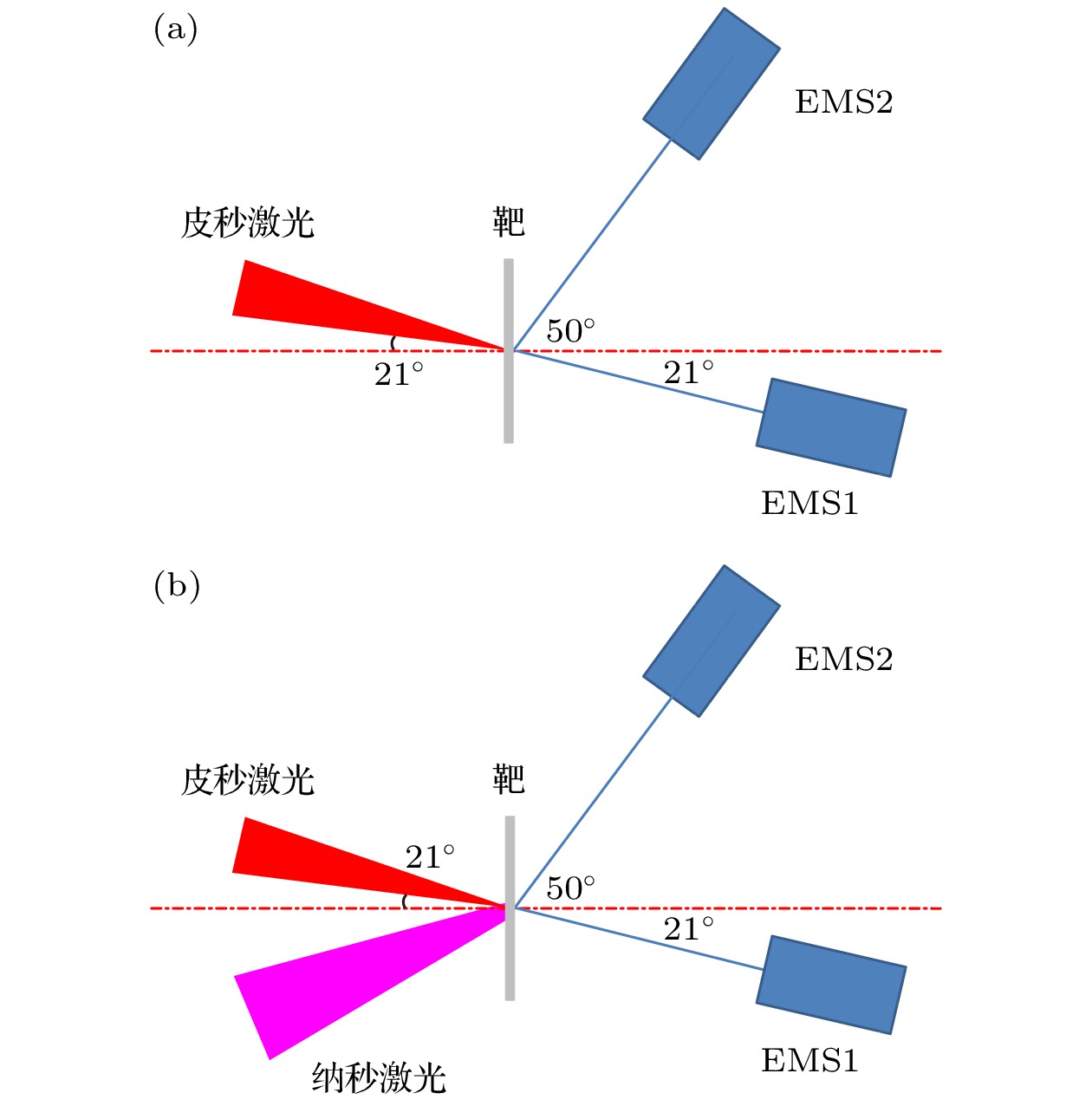
 DownLoad:
DownLoad:

